8 Analyses You Should Perform in a Content Audit

A content audit is a major part of the P.A.C.E. digital marketing audit which helps you determine whether your content is optimized for search engine and aligned with your messaging and marketing goals.
Here are eight analyses you must perform if you want to do your own content audit (related article: SEO Audits: 8 Crucial Components You Must Consider):
-
Meta Tag Analysis
According to Moz, “meta [tags] are HTML attributes that provide concise explanations of the contents of web pages.” To optimize your webpages for search engine, your meta tags should use the following format:
• Title tag: “Primary Keywords – Secondary Keywords | Brand Name” or “Brand Name | Primary Keywords – Secondary Keywords”
• Meta description: 150 to 160 characters.
• Meta keywords: 12 to 15 keywords.
An example would be:
• Title tag: “iPad Air 2 - Tablet | Apple Store” or “Apple Store | iPad Air 2 – Tablet”
• Meta description: Order iPad Air 2 from the Apple Store and receive fast, free shipping. iPad Air 2 features a 9.4 inches Retina display and a 10-hour battery.
• Meta keywords: iPad Air 2, iPad, tablet, mobile device, mobile tablet, retina display, apple store, iPad Air, Apple iPad, Apple Store, iOS, iOs tablet
Forming your meta tags using the above format helps Google understand the content of your webpage better so it can rank you for related queries. -
"No follow" Analysis
“Nofollow” is a search engine-specific attribute that prevents others from transferring SEO “link juice” or page authority from your website to an external page. When a page has the “nofollow” attribute, search engines will index the page but won’t follow any of the links on that page.
When a specific link carries the “nofollow” attribute, search engines such as Google won’t follow that link. This prevents your page authority from being diluted when:
• Spammers or other entities try to use your webpage to add backlinks to their own site
• You are linking out to a page you don’t necessarily want a search engine to associate with your own site
• You don’t want to boost another website’s page rank
Pages that gain the most from “nofollow” are websites where visitors are allowed to make comments such as forums and blogs. It won’t stop 100 percent of spammers from getting “SEO juice” from your site to theirs but it’ll help a lot. To do this, or to check whether “nofollow” is being used for a page, at the page-level meta tag, look for this:
<meta name=”robots” content=”nofollow” />
For linking out, if you want to use “nofollow” to avoid transferring authority to an article you’re linking to from your blog, insert it in an <a> tag along with the href.
For example, for the article, 5 AdWords Remarketing Campaigns Every Retailer Should Implement, you would do this:
<a href=”http://www.smartt.com/insights/5-adwords-remarketing-campaigns-every-ret... rel=”nofollow”> 5 AdWords Remarketing Campaigns Every Retailer Should Implement</a>
This helps you keep your authority and search ranking. -
Poison Link Analysis
Poisonous links are links from bad neighborhoods such as spammy directories or link farms.
Google will lower your search ranking or remove your website completely from search results as punishment for receiving poisonous links.
To discover whether you've attracted poisonous links, access your Google Webmaster Tools account, click on Search Traffic section, and then click on Links to Your Site. Doing so will let you see all links linking to your website - including poisonous links.
If you discover that you're getting poisonous links, you can disavow them by taking the following steps:
• Go to Google Webmaster Tools
• Go to the Dashboard, click Search Traffic, and then click Links to Your Site
• Under Who Links the Most, click More
• Click on Download more sample links to generate all of your inbound links
• Add each poisonous link you want to disavow in a text file line by line
• Go to the disavow links tool page
• Click Disavow links
• Click Choose file
Once you’ve uploaded the file, Google will disavow the links. -
Alternative Text Analysis
Alternative text, or “alt text,” is textual or semantic descriptions of images on your website. These descriptions help Google gain a better understanding of the content and context of the images. This helps these images get rank (get included) on Google Images for relevant keywords. For instance, including the description “iPad Air 2″ for iPad Air 2 helps the tablet rank on Google Images for tablet- related search queries.
Alternative text also helps Google better understand the content of the page that the image is on – which helps the page rank for targeted keywords.
For example, if an image has the alternative text “Tropical Granola,” Google will think that the page the image is on is related to Tropical Granola or other health food-related topics. This helps the webpage rank for Tropical Granola and other nutrition-related keywords.
Note: while alternative text is helpful, don’t stuff keywords. If you have an image of an iPad Air 2 on your webpage, write “iPad Air 2” as the alternative text. Don’t write “Apple iOS iPad Air 2 table mobile device retina display.” Stuffing keywords will cause Google to penalize you by lowering your search ranking or removing your site from search results. -
Internal Link Analysis
An Internal link is a link from one of your own webpages to another internal page.
Just like an inbound link (link from an external site), an internal link can help boost your search ranking (though minimally) of your website because you’re passing ‘SEO juice’ from your webpages to other internal pages.
To perform an internal link analysis, visit your blogs and see whether they’ve included links to relevant blogs and services.
For example, if you’re Coastal Contacts and have recently written an article about Ray Ban sunglasses, visit the blog and see whether you’ve included links to other articles about Ray Ban or branded sunglasses and product pages in the blog. If you discover that you haven’t included links to relevant webpages, use Google Advanced Search to find relevant pages on your website and include links to those pages in the blog.
To find relevant articles using Google Advanced Search, enter targeted keywords such as “Ray Ban glasses” or “Gucci glasses” in the all these word section and your blog or website URL (e.g. http://www.clearlycontacts.ca/thelook/) in the site or domain section.
Once you’ve done so, Google Advanced Search will generate blogs or webpages that are relevant to the keywords you’ve entered.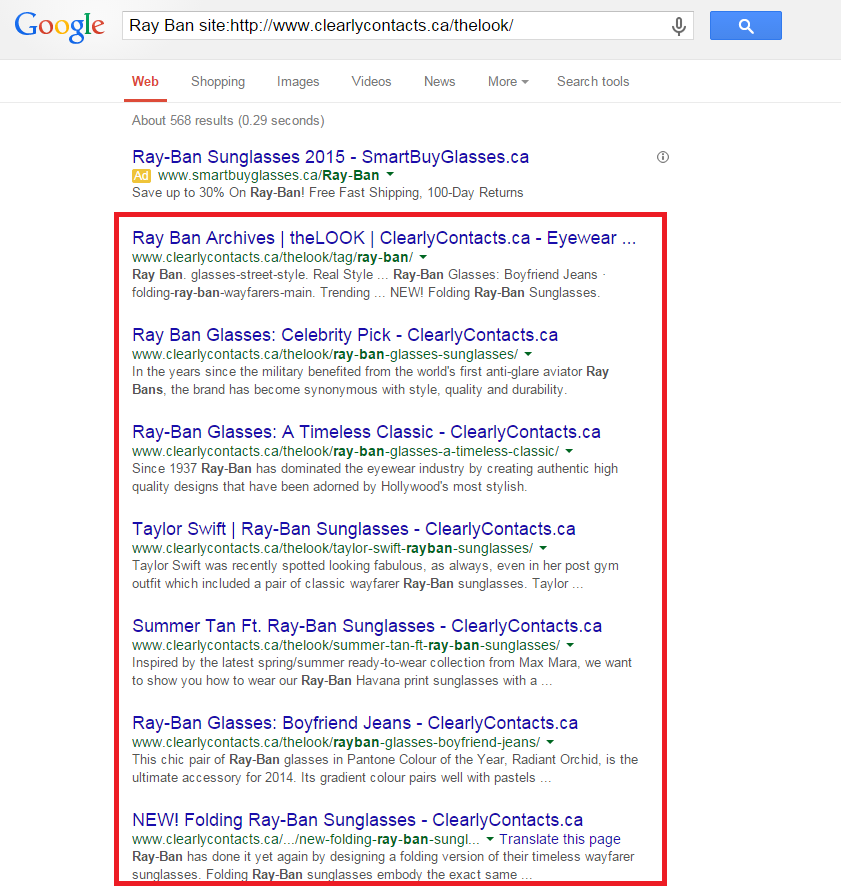
-
Social Media Sharing Button Analysis
Social media sharing buttons are icons that let readers share content directly on webpages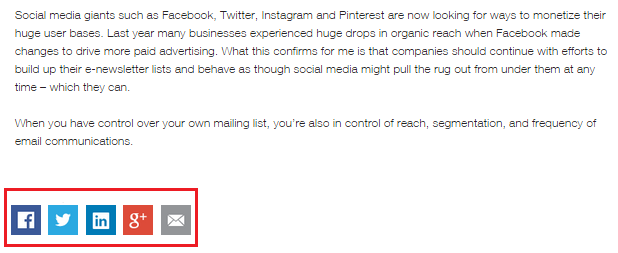
Social media icons can help increase social sharing because readers are more likely share content that can be easily distributed.
According to JeffBullas.com, including social media sharing icons on websites can improve social sharing by 700%. This means that if you articles originally receive an average of one share per blog, adding social media icons can potentially help you gain seven shares!
To perform a social media sharing button analysis, browse through a few of your service pages and blog pages and see whether they’ve social media icons on them. If you discover that there aren’t any, you can install social sharing icon plugins such as AddThis or ShareThis on your website. -
Content Keywords Analysis
A Content Keywords Analysis lets you determine how Google perceives you website. For example, you can conduct a Content Keywords Analysis to find out that Google thinks your website is about “Nike running shoes,” “Adidas runners,” or “fitness equipment.”
To perform a Content Keywords Analysis, go to your Google Webmaster Tools account, click on Google Index, and then click on Content Keywords.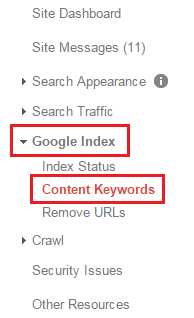
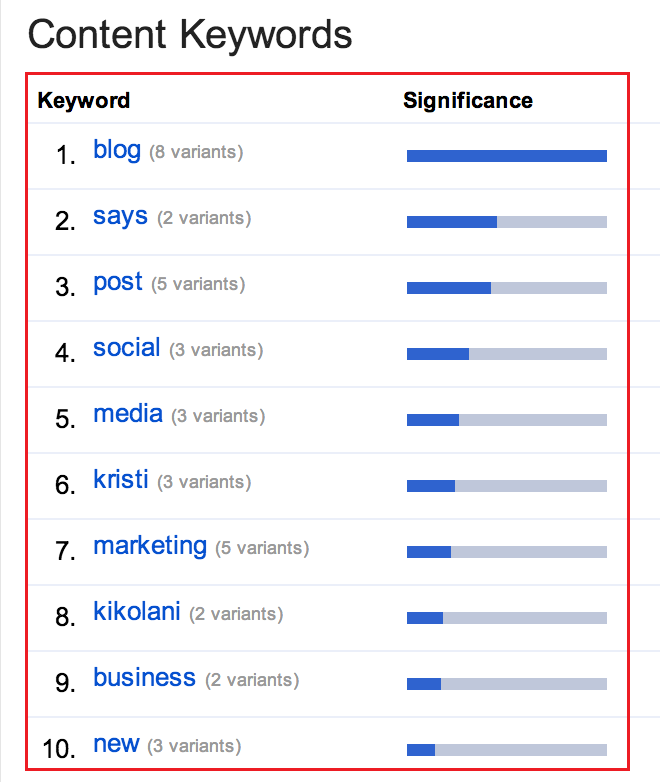
(Image by: Positionly)
If you discover that the keywords listed in Content Keywords aren’t closely related to your brand – which means there’s a misalignment between how Google perceives your company and how you want Google to view it – you can alter Google’s perception by adding more targeted keywords in your content.
For example, if you want Google to think that your brand is about “nutrition products,” “organic drinks,” or “vitamins,” include those keywords more frequently in your web content. -
HTML Headings Analysis
Perform a HTML Headings Analysis to see whether you’re using H1 tags in your content.
According to Search Engine Journal, “H1 tag has long been an example of an influential ranking factor and important signal to search engines as to what a page of content is about.”
You can use H1 tags to emphasize your headings. This will help Google understand what your content is about and rank you for related keywords.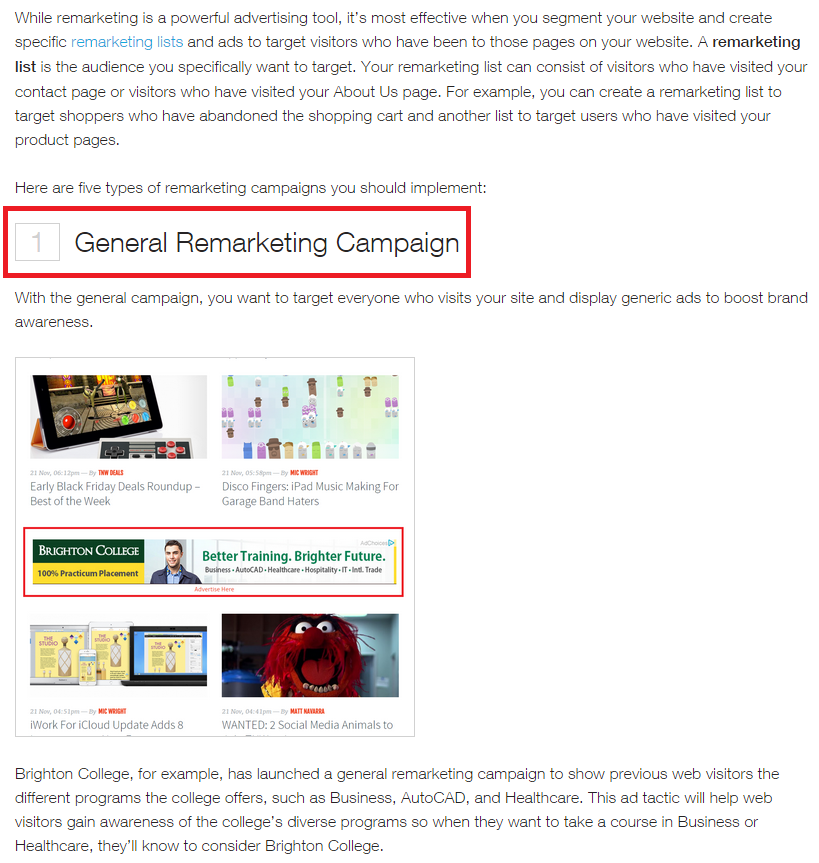
For example, if RBC Royal Bank has “Welcome to Online Banking” as one of its headings, using <h1> tag to bold, enlarge, and emphasize the heading will help the bank rank for search queries such as “online banking.”
To perform a HTML Headings analysis, visit the HTML version of your webpage and see where you’ve used <h1> and </h1> tags for your headings.
Content marketing remains one the most important component of digital marketing. Hence, it’s crucial for you to perform a content audit bi-annually to determine whether you’re following content marketing best practices.
If you want professional help with performing a content audit, please contact Ray at ray.wang@smartt.com. If you want to learn more about content marketing and other programs in digital marketing, register for our next digital marketing training course. If you are interested in receiving a website audit or a digital marketnig audit, please contact us via contact form.


